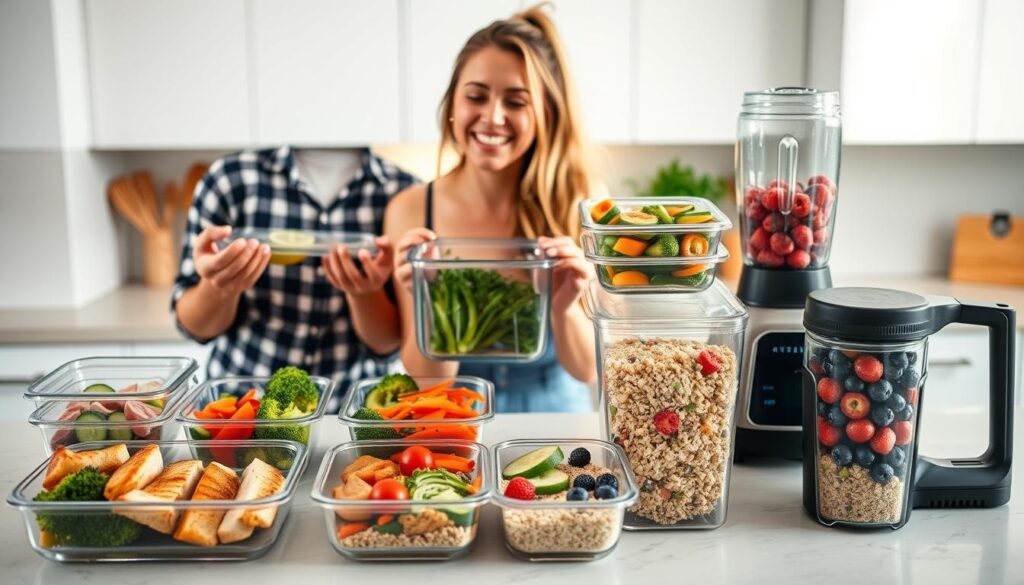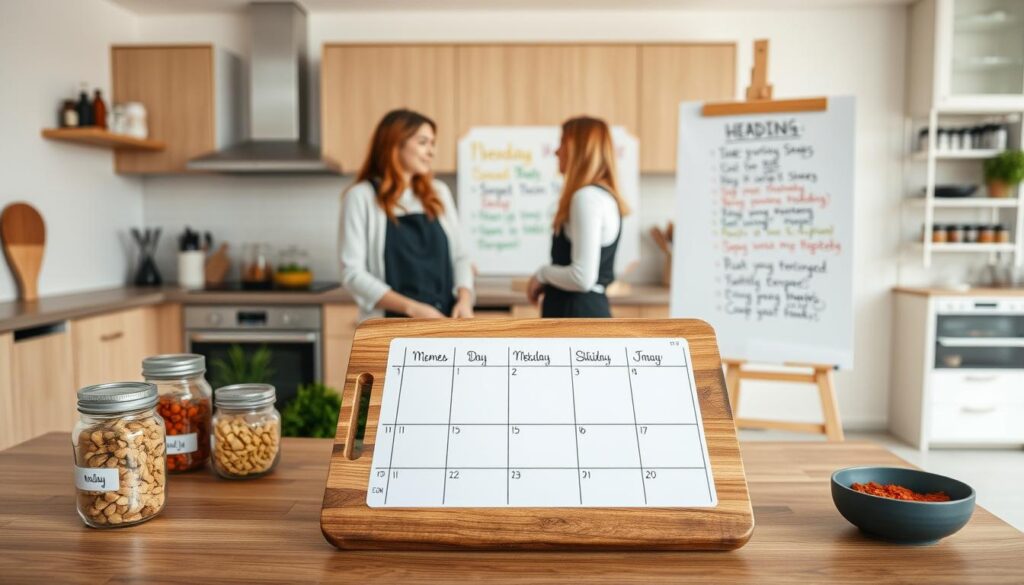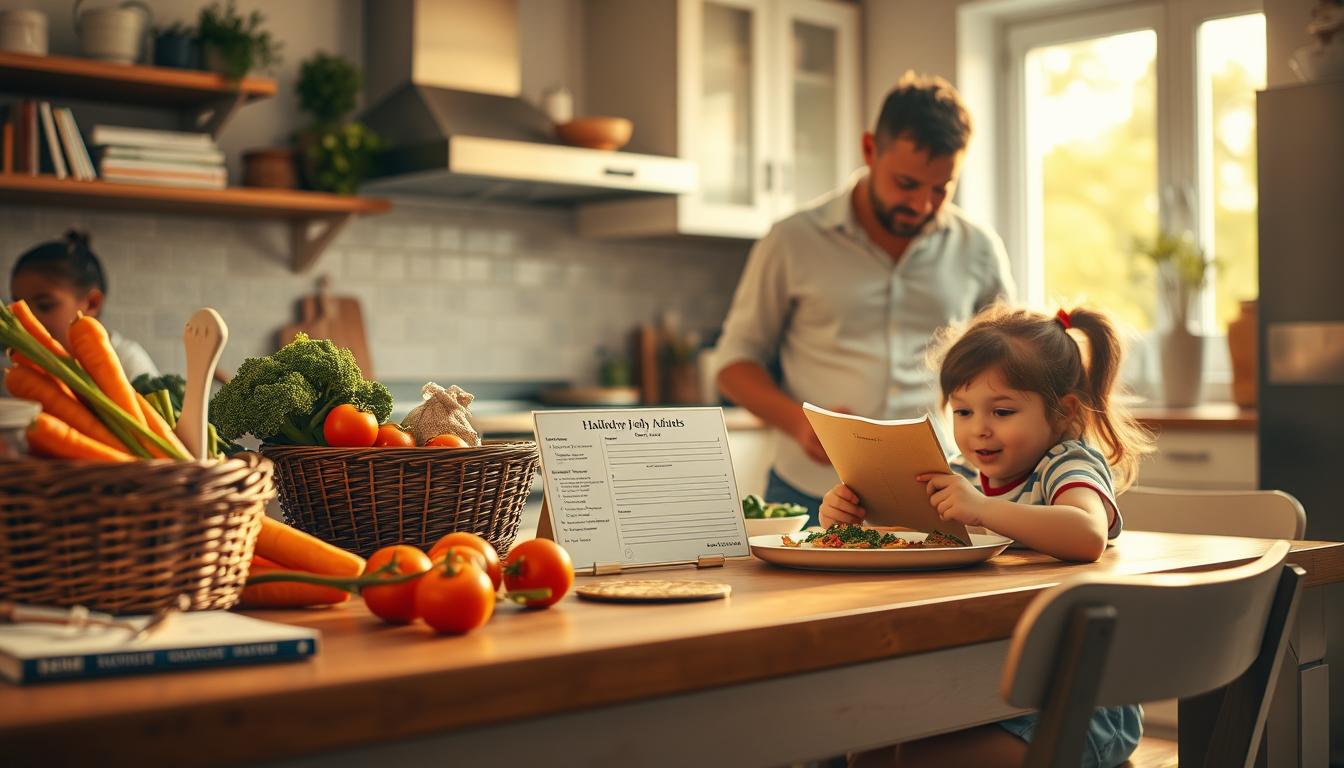Managing mealtime as a busy family can be tough. But, with good meal planning strategies, it gets easier. You’ll eat healthier and feel less stressed.
Using smart family meal planning tips saves time and money. It also makes dinner fun for everyone. This article helps you start or improve your meal planning. It’s easy to follow for meal planning for beginners.
Key Takeaways
- Simplify your family’s meals with effective meal planning
- Reduce stress and promote healthier eating habits
- Save time and money with practical meal planning techniques
- Make mealtime more enjoyable for everyone
- Get started with meal planning for beginners
Understanding the Benefits of Meal Planning
Meal planning is a big help for busy families. It brings many benefits that can change your daily life. Planning meals ahead can make your week easier, save money, and help you eat healthier.
Save Time and Reduce Stress
Meal planning saves a lot of time. It lets you decide on meals early, making dinner prep easier. This way, you can cook in batches and prep ingredients ahead.
It makes your evenings less stressful. You won’t have to rush to make dinner anymore. Your evenings will be more relaxed and fun.
Save Money on Your Grocery Bill
Using a budget-friendly meal planning method can save you a lot on groceries. Plan meals around sales and what’s in season. This way, you avoid buying things you don’t need and waste less food.
It helps you use your money better. You can spend it on other important things.
| Meal Planning Strategy | Potential Savings |
|---|---|
| Planning meals around sales | Up to 20% on grocery bills |
| Reducing food waste | Up to 15% on grocery bills |
| Avoiding impulse buys | Up to 10% on grocery bills |
Promote Healthier Eating Habits
Meal planning helps you eat healthier. It lets you pick meals that are good for you. This way, your family gets the nutrients they need.
It’s a good way to introduce new foods. This makes your family enjoy eating healthy foods. Adding healthy eating tips to your meal plan can make a big difference in your family’s health.
Getting Started with Meal Planning
Starting meal planning can change your life if you’re busy. It makes your kitchen run smoothly and lowers stress.
First, you need to know your family’s needs. You must plan your time and get the right tools.
Assess Your Family’s Needs
Start by figuring out what your family likes to eat. Think about allergies, dislikes, and cultural foods. This helps make a meal plan that everyone will like.
Use a simple table to keep track of what your family likes:
| Family Member | Dietary Restrictions | Food Preferences |
|---|---|---|
| John | Gluten-free | Pizza, Pasta |
| Jane | Vegetarian | Salads, Stir-fry |
| Child 1 | None | Mac and Cheese, Chicken Tenders |
Set Aside Time for Planning
Choose a time each week for meal planning. It could be Sunday evening or Wednesday morning. Pick a time that works for you.
Use this time to look at your week, see what you already have, and plan meals. You can use a planner, app, or notebook.
Gather Necessary Supplies
You’ll need some basic things for meal planning. These include a meal planning calendar, a grocery list app, or recipe cards. The right tools make planning easier and fun.
Some great tools are:
- Meal planning apps like Plan to Eat or Yummly
- A physical planner or calendar for meal planning
- A note-taking app for quick grocery lists
By starting with these steps, you’ll set up a great meal planning routine for your family.
Choosing the Right Recipes
Choosing the right recipes is key to stress-free meal planning. It’s important to pick healthy and tasty meals for your family. With so many options, it can feel overwhelming.
Involve the Family in Recipe Selection
Getting your family involved in picking recipes makes mealtime fun. Ask each family member for their favorite dishes. You can also look through cookbooks and websites together.
Focus on Simple and Quick Meals
Busy families need quick and easy meals. Look for recipes that can be made in 30 minutes or less. These meals save time and reduce stress on weeknights.
Try meal planning for weight loss by picking low-calorie, nutrient-rich recipes.
Consider Nutritional Balance
It’s important to make sure your meals are balanced. Choose recipes with a variety of foods like veggies, lean proteins, and whole grains. This supports health and helps with weight loss.
Adding healthy eating tips to your meal planning can greatly improve your family’s health.
Creating a Weekly Meal Plan
Creating a weekly meal plan saves time and reduces stress. It ensures healthy meals for your family. It also cuts down on food waste and saves money.
To make a good meal plan, think about your family’s schedule and what they like to eat. Plan meals for each day, keeping in mind your family’s tastes and any special events.
Organize Meals by Day
Start by mapping out your meals for the week. Look at your family’s schedule for each day. Plan quick meals for busy days and bigger meals for days when you have more time.
- Start with breakfast ideas, such as overnight oats or scrambled eggs.
- Plan lunches that are easy to prepare, like sandwiches or salads.
- Choose dinner recipes that can be prepared in advance, such as slow cooker meals or casseroles.
Plan for Leftovers
Planning for leftovers helps reduce waste and saves time. Think about meals that can be reheated or used in other dishes. For example, leftover roasted chicken can make chicken salad or soup.
“Cooking is not just about the food; it’s about the love and care you put into it.”
Adjust Portions According to Family Size
When planning meals, adjust portion sizes for your family. Use a meal planning template or app to scale recipes. Think about the ages and appetites of your family members when deciding on portions.
By following these steps, you can make a meal plan that fits your family. Remember to be flexible and adjust your plan as needed.
Building a Flexible Grocery List
To make meal planning work for you, it’s key to have a flexible grocery list. This list should change with your needs and likes. A good list keeps you on track, cuts down on food waste, and saves money.
Categorize Items by Food Group
Begin by sorting items into food groups. This ensures you get all the nutrients you need. You’ll have fresh veggies, proteins, whole grains, dairy, and snacks. This way, you can see what’s missing and make smart choices at the store.
Include Pantry Staples
Adding pantry staples to your list is crucial. They are the base of your meals and help you cook quickly. Things like olive oil, spices, canned goods, and pasta are key. They help you make many dishes and are great for budget-friendly meal planning.
Make Adjustments Based on Sale Items
To save money, adjust your list for sale items. Look at the weekly ads and plan meals around what’s on sale. This not only saves cash but also lets you try new recipes and ingredients in your meal prep recipes.
By doing these steps, you can make a list that fits your family and budget. Think about using a meal planning app to stay organized and get the most from your shopping.
Preparing Meals in Advance
Preparing meals ahead of time is a big help for busy families. It saves time and cuts down stress. You can make healthy meals for the week in just a few hours.

Batch Cooking for Busy Days
Batch cooking is a smart way to save time. It means making lots of one thing or a whole meal at once. This is great for days when you’re too busy to cook from scratch.
Some easy meal prep ideas include making lots of rice or roasted veggies. You can also cook proteins like chicken or beans for different meals.
Freezing Meals for Future Use
Freezing meals is another great idea. It lets you make meals ahead and save them for later. Use airtight containers or bags to keep them fresh.
Good meal prep recipes to freeze are casseroles, soups, and single portions of meals. Labeling them helps you use the oldest ones first.
Prepping Ingredients for Quick Cooking
Getting ingredients ready ahead of time can make cooking faster. Chop veggies, marinate meats, or prep other ingredients. This way, you can make a meal quickly.
Start by doing a “mise en place” for your meals. Chop all needed veggies and ingredients and store them in the fridge. This saves a lot of time.
| Meal Prep Technique | Benefits | Examples |
|---|---|---|
| Batch Cooking | Saves time, reduces stress | Cooking large batches of rice or roasted vegetables |
| Freezing Meals | Convenient, reduces food waste | Casseroles, soups, individual meal portions |
| Prepping Ingredients | Reduces cooking time, promotes healthy eating | Chopping vegetables, marinating meats |
“Meal prep is not just about saving time; it’s about making healthy choices and enjoying quality time with your family.” – Nutrition Expert
Making Use of Technology
Technology changes meal planning for the better. It helps organize meals and grocery lists. Many digital tools are out there to make meal planning easier. This saves time and lowers stress.
Meal Planning Apps and Websites
Meal planning apps and websites have cool features. They help a lot with planning meals. Here are some:
- Recipe suggestions based on what you like and what’s in stock
- Meal planning calendars to plan meals for the week
- Grocery list generators to remember all you need
Plan to Eat and Yummly are great apps. They let you organize recipes, plan meals, and make grocery lists.
Online Grocery Shopping Tools
Online grocery shopping saves a lot of time. Many stores let you shop online. You can pick up your order or get it delivered. Here are some top sites:
| Platform | Features |
|---|---|
| Instacart | Delivery from local stores, real-time tracking |
| Shipt | Same-day delivery, membership benefits |
| Peapod | Weekly specials, coupons, and easy reordering |
Recipe Management Solutions
Recipe management tools keep your favorite recipes in one spot. They make meal planning easier. You can:
- Save recipes from anywhere
- Manage your own recipe book
- Make grocery lists from your recipes
Using these tools makes meal planning better. It’s more fun and fits your family’s needs.
Encouraging Healthy Choices
Meal planning helps your family make healthy choices. It ensures everyone eats well. You make smart food choices when you plan meals.
Introduce New Foods Gradually
Adding new foods slowly is a smart move. Start with a new veggie or fruit each week. Try different foods to keep things fun.
Tips for Introducing New Foods:
- Start with small portions to avoid overwhelming your family.
- Involve your family in the process of selecting new foods.
- Be patient, as it may take time for new foods to become favorites.
Create a Snack Plan
Having a snack plan stops unhealthy snacking. Plan ahead for snacks like fruits, nuts, and carrot sticks with hummus. This keeps you away from junk snacks.
Healthy Snack Options:
| Snack | Nutritional Benefits |
|---|---|
| Fruits | Rich in vitamins, minerals, and antioxidants. |
| Nuts | Good source of healthy fats and protein. |
| Carrot sticks with hummus | High in fiber and vitamins. |
Engage Kids in Meal Preparation
Getting kids to help in the kitchen is great. It teaches them cooking skills and encourages trying new foods. Give them tasks based on their age and ability.
By getting your kids involved, mealtime becomes fun and learning.
Staying Organized During the Week
Good meal planning is more than picking recipes. It’s also about staying organized all week. You need a few simple strategies to keep up.
Use a Family Calendar
Using a family calendar is a great way to stay organized. It can be a physical calendar or a digital one. This helps everyone keep track of their schedules.
It makes planning meals easier. You can plan meals for busy days. And you’ll always know what to make for dinner.
Designate a Meal Prep Day
Picking a special day for meal prep helps a lot. On this day, you can batch cook meals and chop veggies. You’ll also prepare ingredients for the week ahead.

Keep a Running List of Grocery Needs
It’s key to keep a running list of grocery needs. Add items as you run out or plan new meals. This keeps you ready and lets you adjust based on sales or what’s in season.
Some more time-saving meal planning strategies include:
- Planning meals around what’s on sale at the grocery store
- Using one-pot recipes to simplify cooking and cleanup
- Prepping ingredients in advance to make cooking faster
These strategies help you enjoy easy meal prep ideas. They make meal planning more organized. This saves time and helps you eat healthier.
Reflecting on Your Meal Planning Process
As you start your meal planning, it’s key to check how it’s going. Look at what’s good and what needs work. Also, ask your family for their thoughts and make changes if needed.
Evaluating Success
Review your meal planning often. Think about how much time you save, how much money you spend, and if your meals are healthy. This helps you see what you can do better.
Incorporating Family Feedback
Get your family’s opinion on meal planning. This makes sure everyone likes the meals. It helps make meal planning easier for beginners.
Making Adjustments
Be ready to change your meal planning as you go. Maybe you need to change how much food you make or try new recipes. Being open to change keeps your meal planning on track.
FAQ
How do I start meal planning as a beginner?
First, figure out what your family likes to eat. Then, set aside time to plan meals. You’ll need a planner or app for this.
Look for meal planning templates and online tips to help you start.
What are some easy meal prep ideas for busy families?
Try batch cooking and one-pot meals. Slow cooker recipes are great for making ahead.
Also, prep ingredients like chopped veggies, marinated meats, and cooked grains. This makes meals quicker.
How can I save money on my grocery bill through meal planning?
Meal planning helps you avoid buying things you don’t need. It also cuts down on food waste.
Look for sales and discounts. Buy in bulk and use coupons. Shopping at farmers’ markets can also save money.
What are some healthy eating tips for families?
Eat a variety of whole foods like fruits, veggies, whole grains, lean proteins, and healthy fats.
Try to eat less processed food. Teach your kids to eat mindfully.
How can I involve my kids in meal planning and preparation?
Ask your kids for their favorite recipes and meal ideas. Let them help with meal prep.
They can wash veggies, mix ingredients, or stir pots.
What are some time-saving meal planning strategies for busy families?
Use a meal planning app and make a weekly meal plan. Prep ingredients early.
Try cooking meals that can be reheated or used again.
How can I adjust my meal planning routine as needed?
Check your meal planning often. Ask your family for feedback. Make changes as needed.
Think about what works and what doesn’t. Make adjustments to keep things fresh.




